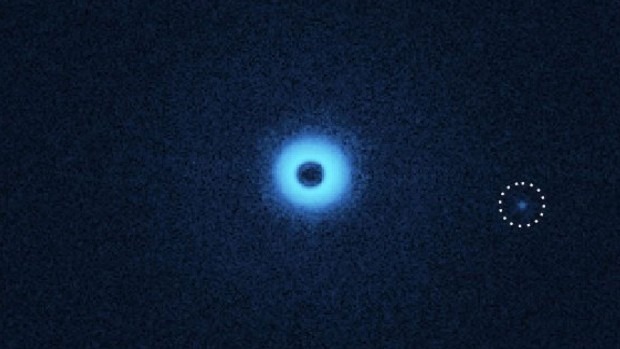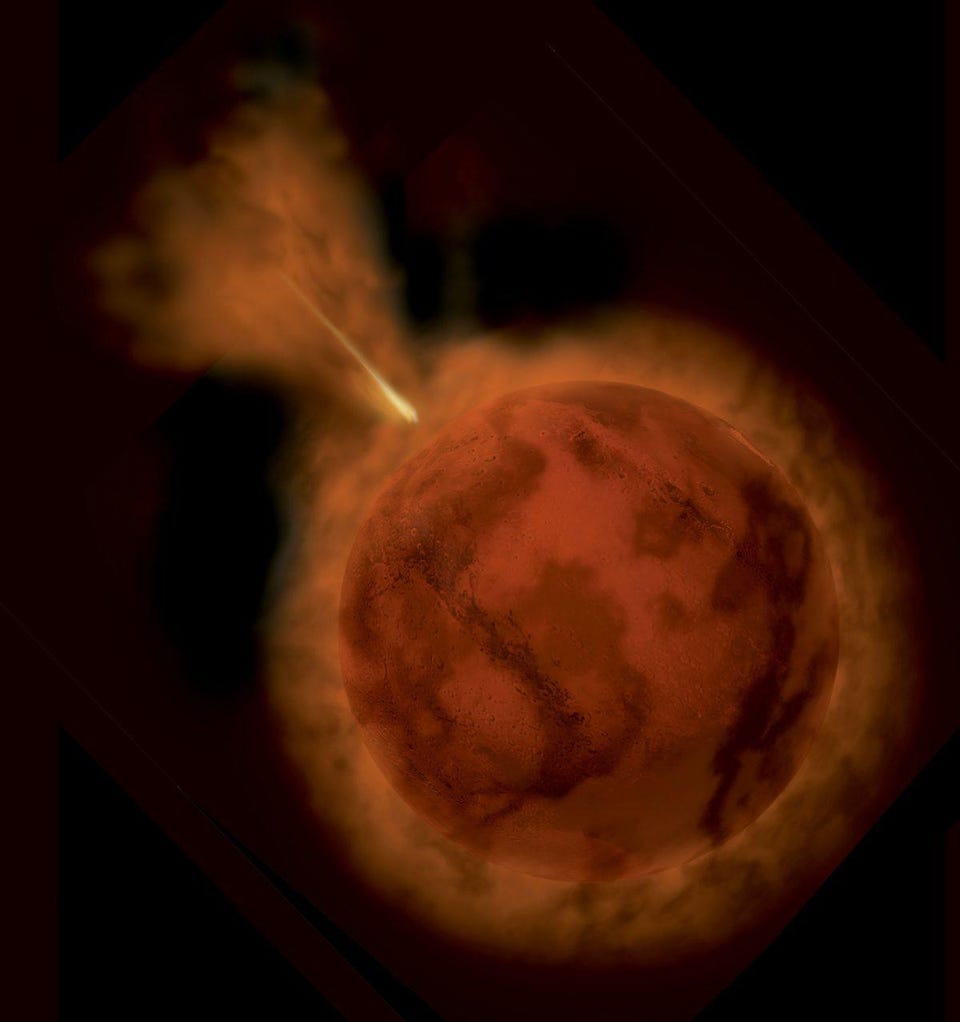Planet found orbiting three stars all at once

- The three-body problem led many to believe that planets couldn’t stably orbit this many stars.
- But GW Orionis, a young, planet-forming system just 1,300 light-years away, has multiple protoplanetary rings orbiting a triple star system.
- A new study shows there must be planets in between those rings, making these the first planets discovered orbiting all three stars in a trinary system.
How many stars can a planet successfully orbit? For a long time, we had only our own solar system to look to, as we were the only star we knew of with planets around it at all. It wasn’t until the 1990s that we found planets orbiting other star systems. Even though stars come in singlets, binaries, trinaries, and even greater numbers of multi-star systems, we’d only ever found stars orbiting one — or, at most, two — stars. Even in systems with three or more stars, planets have only been found orbiting one or two of the stars at once, with the other star(s) farther out.
There had been two main schools of thought as to why this was the case. One idea was that planets can orbit stars either closely, in which case their orbits are dominated by one central star (or a tight binary star) that supplies their gravity, or far away, as long as they’re far enough so that however many stars there are behave like a single mass. According to this idea, the only reason we hadn’t seen planets in wide orbits around trinary (or greater) systems was because it’s difficult to observe. But a rival idea is that wide planetary orbits around three or more stars would be fundamentally unstable, and gravitation would quickly kick out any such planets.
While this was contentious for a time, the mystery has been solved with the GW Orionis system: a still-forming trinary system now known to house planets of its own. For the first time, planets in orbit around all three stars in the system have been found, suggesting this is not only a possible configuration, but a common one. Here’s the story of what we’ve learned.

When it comes to the stars in the universe, you might have heard the incorrect but common refrain that, “our sun is just a typical star.” In some ways, we’re well within the realm of what’s considered normal for a star, but typical is really not the right word when you compare it to the other stars we find both near and far.
When it comes to mass, you can either be much smaller or much larger than the sun and still fuse hydrogen into helium in your core: a key requirement for becoming a star. Stars with as little as 7.5% the mass of our sun, or as much as hundreds of times as massive, all do this throughout the universe, with the less massive stars being redder, cooler, and longer-lived, while the more massive stars are bluer, hotter, and short-lived.
Compared to our sun, however, the overwhelming majority of stars are redder and lower in mass. We aren’t typical. In fact, about 80% of all stars are red dwarfs: stars with no more than 40% the mass of our sun. Although plenty of stars are brighter, bluer, and more massive than the sun — particularly among the stars visible to the naked eye in the night sky — these stars are relatively rare. Putting together all that we know, only about 5% of stars are more massive than our sun; a full 95% are smaller, redder, longer-lived, and less massive than we are.

Similarly, when stars are born, they typically form in large, massive star clusters, triggered by the gravitational collapse of a molecular gas cloud. Instead of forming in isolation, typically hundreds, thousands, or even as many as millions of stars can form all at once, within just a few million years of one another — a cosmic blink of an eye. A wide variety of star systems form inside, where only about 1-in-2 stars form in singlet systems, like our own. About 1-in-3 stars are found in binary systems, where two full-fledged stars dominate their solar system; 1-in-10 compose trinary systems, with three stars; 1-in-40 are in quaternary systems, and about 1-in-100 stars exist in systems with 5 or more stars, all bound together gravitationally.
These star clusters consist of star systems with widely varying masses, and over time, they gravitationally interact, causing lower-mass star systems to get ejected while higher-mass star systems sink to the center. Over longer timescales — typically around a few hundred million years — these star clusters dissociate, populating the galaxy with the individual star systems that formed within them.
But while the stars are forming, something else forms along with them: planetary systems.

Beginning with observations from the Hubble Space Telescope, humanity began seeing, for the first time, these long-predicted planet-forming systems around young stars and protostars: protoplanetary disks. Rotating around young stars, these dusky disks develop instabilities, where some regions of the disks become slightly denser than others. Regions of greater density will preferentially attract more and more of the surrounding matter to them, eventually growing into protoplanets or even full-fledged planets, sweeping up the dust and creating gaps in the disk, leading to a series of dust rings instead.
When the definition of a planet was put forth, this idea of “clearing its orbit” wasn’t arbitrary, but rather was related to this very scenario of planet formation in the first place. In theory, what should have happened in all of these systems was the following:
- protoplanetary disks develop instabilities
- the largest of these instabilities grow and attract other masses
- this eventually leads to the formation of a planet and a cleared orbit, with instabilities and overdensities that form later becoming either less massive planets or sub-planet objects
- the radiation and winds from the central star(s) blow the dust away over time, leading to a mature solar system
Although it took many years and numerous technological advances for these features to be directly observed, we’ve now seen large numbers of protoplanetary disks with these characteristic gaps in them: evidence of newly forming solar systems.
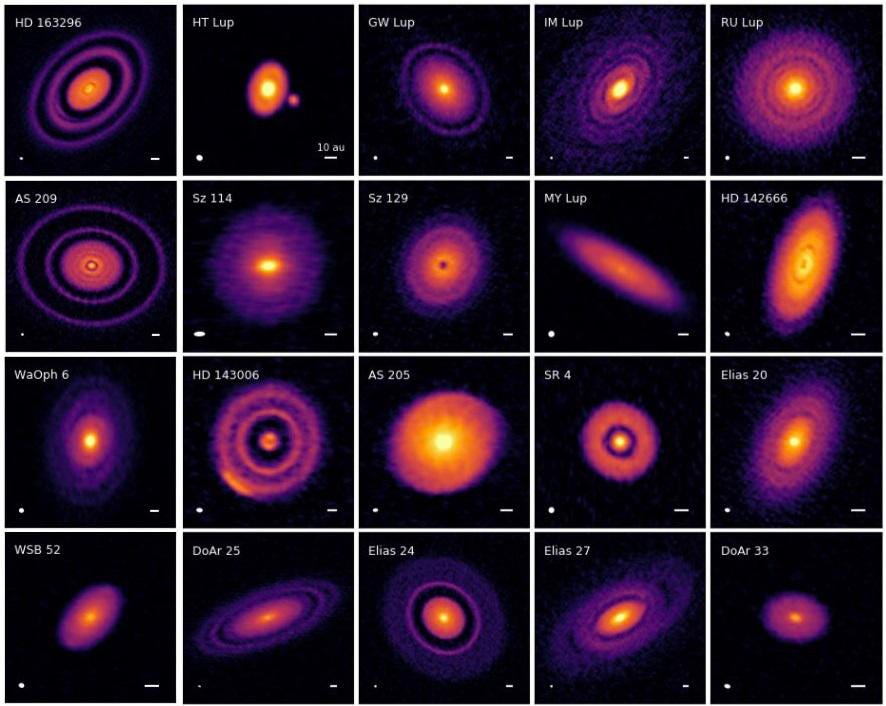
However, you can’t just form a planet anywhere you’d like. There’s a problem in physics when you have multiple masses orbiting one another: the fact that if you have more than two masses bound together, the mutual gravitational tugs exerted will lead to unstable orbits. Over time, planets can get ejected, thrown into a star, or even thrust into orbits where they’ll collide with one another. Simulations of our own solar system indicate that this has happened in the past: we believe we once possessed a fifth giant planet that was ejected long ago. We also know that a Mars-sized body collided with Earth in the solar system’s early days, creating our moon. And even far into the future, simulations indicate that there’s about a 1% chance that one of the four inner planets will be ejected before our sun runs out of fuel.
When you have multiple stars in your system, however, it should be forbidden to have planets that orbit any of the stellar members at approximately the distance separating the stars from one another. In theory, there are three places where planets can form:
- in close proximity to one star, where the gravitational force is dominated by that particular star
- far away from all of the stars, where the stars are so far away that they effectively behave as a single mass
- some combination of the first two scenarios, where a planet is far away from some of the stars but one or more stars is even more distant
However, when it came to trinary systems, these three scenarios didn’t appear to all play out.
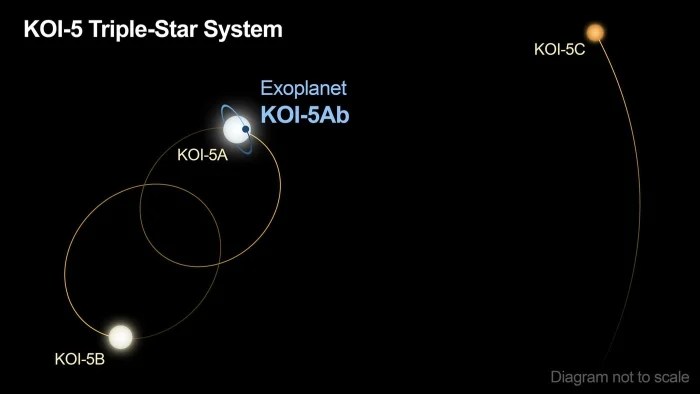
Singlet systems are easy; they’re all like the solar system. Binary systems had been observed to have two locations where planets could form: close in to one star or the other, with the other star much farther away, or at great distances from both stars.
But for some reason, of the 32 trinary systems that were observed to possess exoplanets as of early 2021, all of them only had planets that were either close in around one star, or were close in around a binary, with the third (trinary) member much farther away. There were no known systems where a planet was found orbiting far out, beyond all three stars in a trinary system.
However, there was one intriguing system that showed potential: GW Orionis. Located about 1,300 light-years away, GW Orionis is a young trinary star system that still has its protoplanetary material surrounding it. It was recently observed with the Atacama Large Millimeter/submillimeter Array (ALMA), the most advanced network of radio telescopes ever built on Earth, and humanity’s best tool for imaging these protoplanetary disks directly. Since it became fully operational in 2013, ALMA has revealed more details about more systems. When it imaged GW Orionis, it found something truly spectacular: the largest and most impressive system of dust rings ever seen.
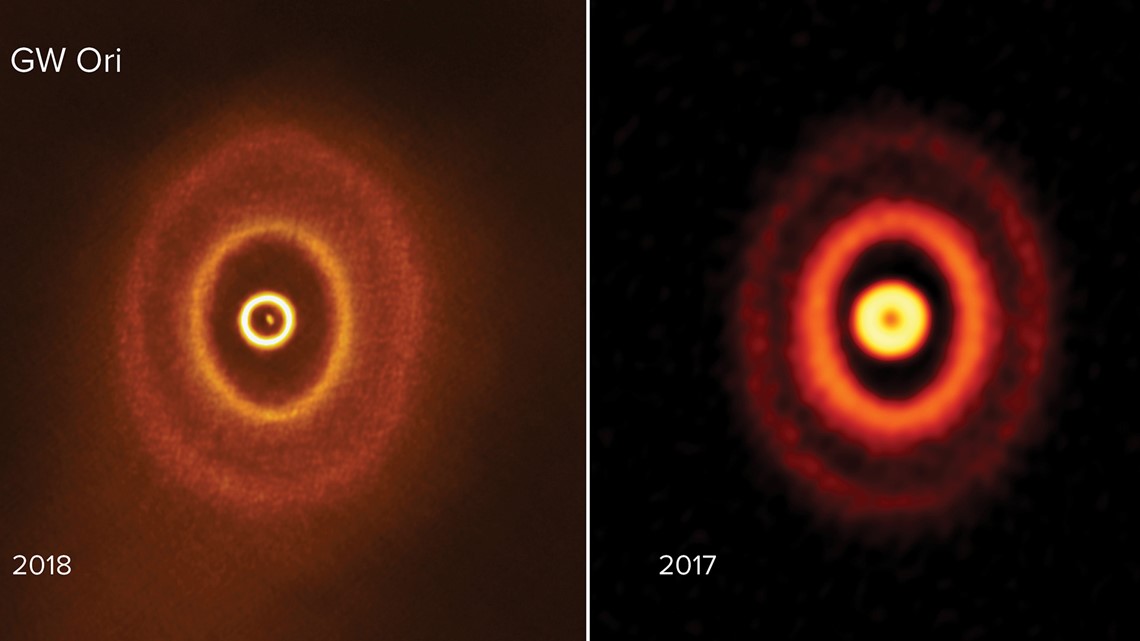
In fact, a simple visual inspection of ALMA’s dust map of the GW Orionis system suggests that there may be planets present in the gaps seen in the dust. However, there’s more to the system than meets the untrained eye, as you may have suspected.
For one, the three stars are set up with two stars orbiting one another at approximately the Earth-Sun distance, with the third star farther away at approximately the distance of Saturn.
The dust, however, extends for a great distance: up to approximately 400 times the Earth-Sun distance, or about 10 times the extent of our solar system’s Kuiper Belt.
Furthermore, the disk is broken up into three rings that each:
- are comparable in mass to large gas giant planets
- are all tilted and misaligned with respect to one another
- display a total of at least three gaps
Does this mean, then, that this is a slam dunk of a detection that shows we can indeed have trinary systems where not only planets, but also dust rings can stably orbit outside of all three stars?
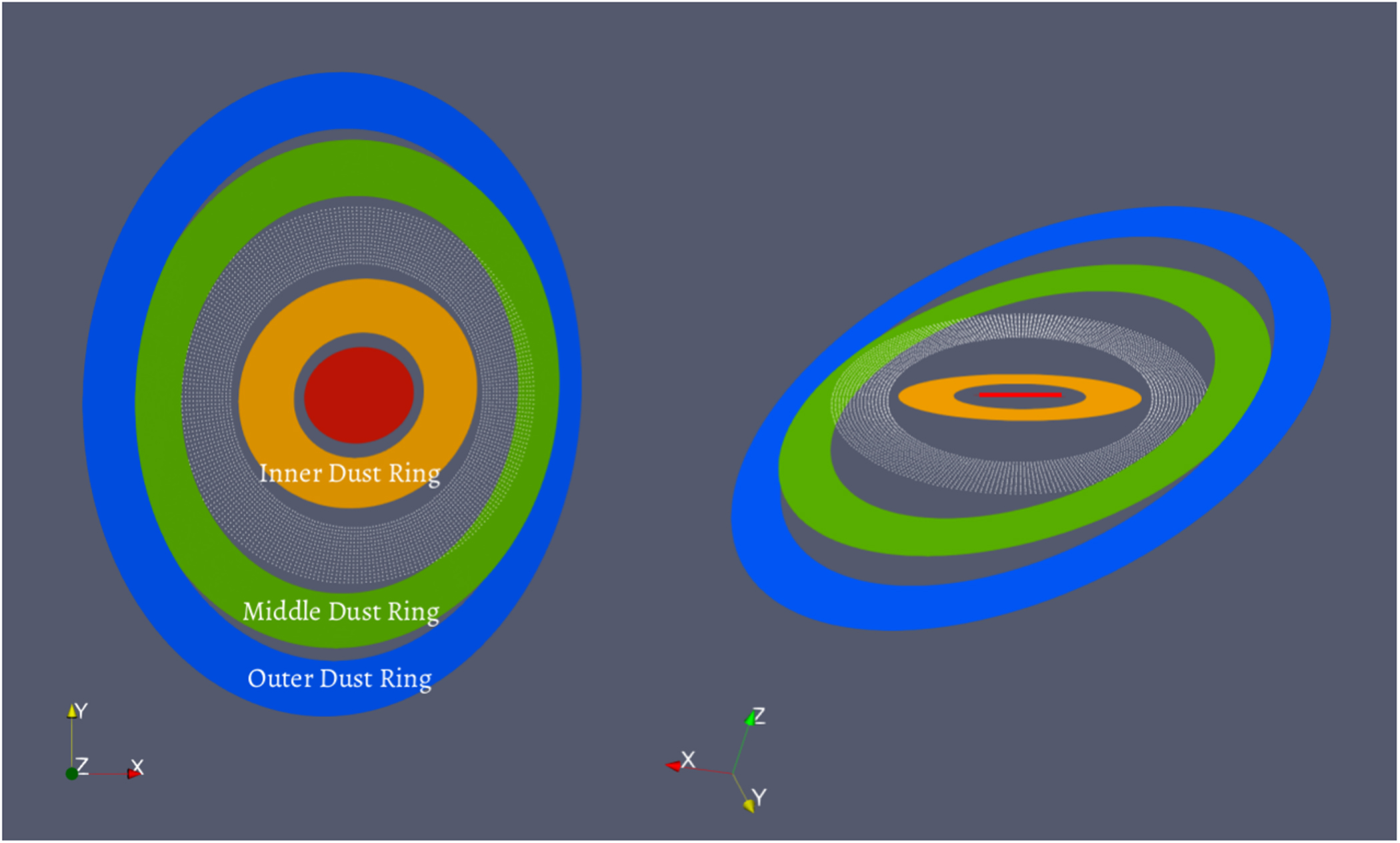
Initial observations were suggestive of this, but it wasn’t a sure thing. Yes, copious amounts of dust, summing up to about twice the mass of Jupiter, are found orbiting outside of these three young, relatively concentrated stars. Yes, there are three independent dust rings, with major gaps between them. But that doesn’t have to mean planets, particularly because the disks are misaligned.
Why are the disks misaligned?
One theory is that the three stars themselves must be misaligned; the orbit that the two innermost stars have, orbiting one another, must be inclined at a significant angle to the third, outermore star. Stars that orbit at severe inclinations to one another can exert torques on both interior and exterior matter, so that if the disk remained continuous, it would be warped.
Two earlier studies then reached opposite conclusions when it came to the gaps: one study concluding that the misaligned stars could not cause the gaps, while the other concluded that, in fact, they could.

That’s why this newest study was so important. It used a new method — fully three-dimensional hydrodynamical simulations, with both thin and thick dusty disks — to determine what sort of evolutionary tracks are possible. It simulated these disks both with and without initial “seeds” for potential planets in between the disks, aiming to see whether either of these scenarios could reproduce the observations. And then, most importantly, when they found which parameters did and didn’t reproduce the observations, they went back to determine which solutions were physically feasible.
The new study, led by Jeremy Smallwood, showed that the only way to get these “breaks” in the disk without planets — so that you wind up with disconnected dust rings — requires that you assume unrealistic values for the density of the dust within the disk. If you assume realistic values, the disk bends and warps severely, but you won’t get any breaks. However, an initially massive planet can continuously open a gap within a disk. It’s very easy if the disk is thin, and it’s also possible if the disk is thick, as long as the planet is well-coupled to the surrounding gas. The multiple breaks, with gaps, therefore indicate planets: the first exoplanets, and the first circumstellar dust rings, found to orbit around at least three stars.
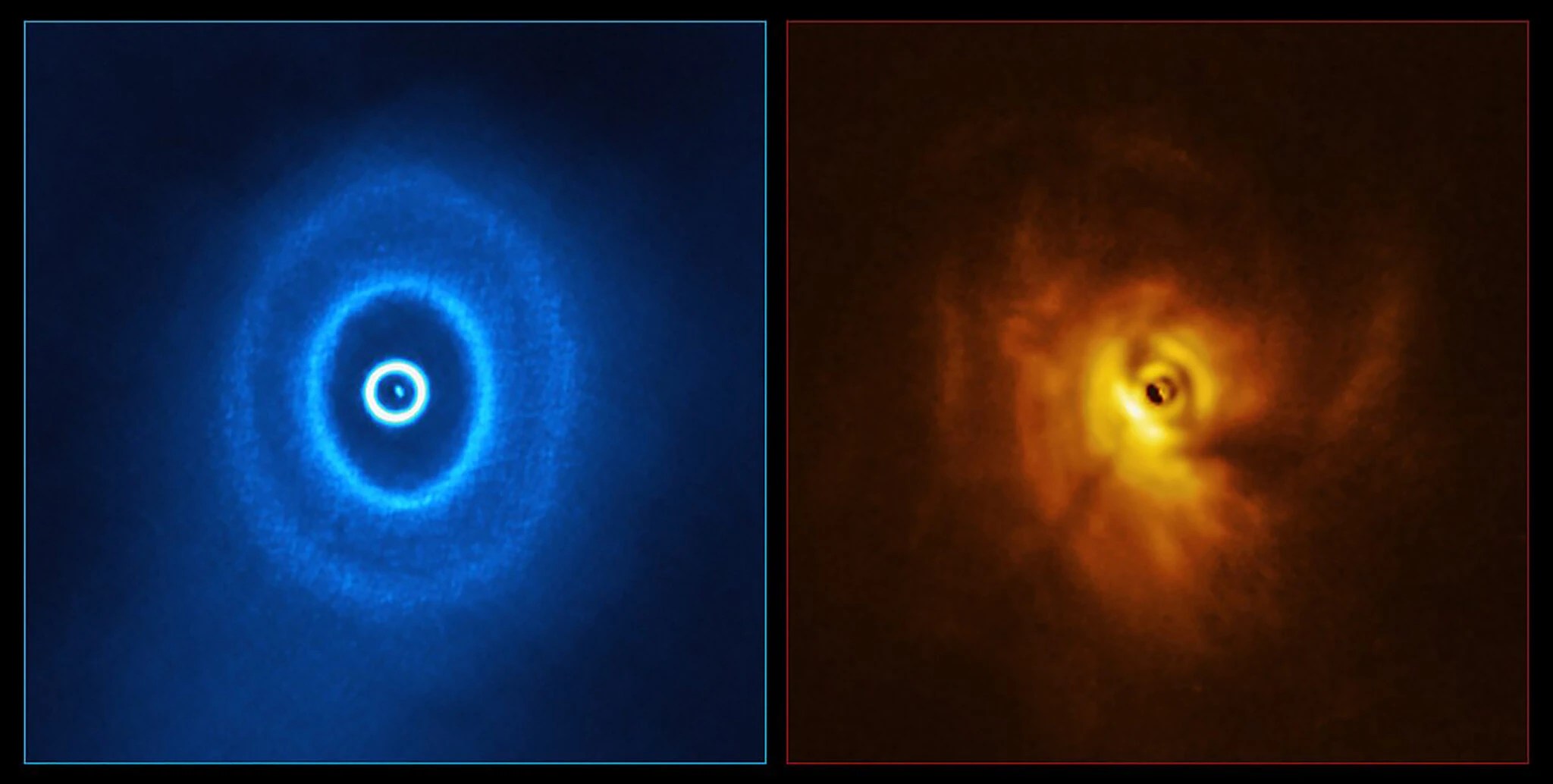
In the span of a mere 30 years, we’ve gone from discovering the very first planets around solar systems other than our own to learning how and where they form — not only in star systems like our own, but also in binary and trinary systems. As of today, we have 32 known exoplanet systems where there are at least three stars for the planets to orbit. One of them, GW Orionis, has three tilted and large outer dust rings, separated by major gaps. This is now interpreted as clear evidence for planets that orbit at great distances from these parent stars.
Although we have yet to demonstrate that these orbits will remain stable over multi-billion year timescales, this new research strongly suggests that planets don’t just form and persist in the inner or intermediate regions of trinary star systems, but also well beyond the orbits of all three stars. It also sets us up for some fascinating tests down the road, because simulations predict that the planets that exist should be further inclined to both the disk and the orbiting stars. The planet(s) could either be quite massive or low in mass, as both scenarios can reproduce conditions consistent with these observations.
For the first time, we can not only go beyond Tattooine, with three stars in a planet’s sky, but beyond all other trinary systems: to a set of planets that orbits around all three stars at once.

